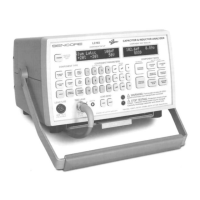28
RS-232 OPERATION
All of the LC103 ReZolver tests may be totally
automated or incorporated into a computer controlled,
automated test system using an RS-232 serial interface.
The LC103 may have either of two functions. As a
“listener” it can receive instructions from the computer
to change functions or ranges. The LC103 listener
functions provide complete automation, as the computer
is able to send any values or tolerances needed for
good/bad testing comparisons and can select any of the
ReZolver test functions.
As a “talker” the LC103 can send readings back to the
computer as the computer requests them.
CONNECTING TO THE COMPUTER
Use a cable with straight through connections on the
ground, transmit data, and receive data lines to connect
between the computer’s serial port and the RS-232
INTERFACE JACK on the rear panel of the LC103.
Software handshaking (Xon/Xoff) is used, so hardware
handshaking connections on the connector are not
needed. The LC103 is configured for 9600 Baud, 8 data
bits, 1 stop bit, and no parity. The computer’s serial port
should be configured the same way. Communications
software used in the terminal mode and commercial
instrument control software have menu options for
setting the port configuration. If you write your own
control software, you should specify the serial port
configuration when you address the port (in a Basic
“open” command, for example).
Fig. 17: Connecting the LC103 to a computer for
automated control.
The LC103 is configured as a DCE (Data
Communications Equipment) device, which means that
it should be connected to your computer with a cable
having DB9 connectors on both ends and straight-
through wiring between pins 2, 3, and 5.
Following is a list of the RS-232 9-pin connector lines
used by the LC103:
Fig. 18: Use a cable having straight through
connections for transmit, receive, and ground.
There are two types of handshaking used by RS-232
devices, software and hardware. With software
handshaking, Xon (CTRL-Q) and Xoff (CTRL-S)
characters are automatically transmitted on the data lines
to control data flow. With hardware handshaking,
voltages are placed on separate handshaking lines to
control data flow. The LC103 supports only Xon/Xoff
software handshaking, which means that hardware
handshaking lines are not needed.
SENDING DATA TO THE LC103
As a listener, the LC103 accepts commands from the
computer. These commands can be used to select a
function or to send parameters to the LC103 for
GOOD/BAD comparison testing. The commands sent to
the ReZolver during bus operation duplicate the front
panel pushbuttons. Follow the same programming
sequence and range limits as for manual (non-RS-232)
operation.
The listener codes consist of one, two, or three
characters, and relate to the function being selected or
the data being entered. Most listener codes consist only
of the code characters. The listener codes used to enter
data for good/bad testing consist of a number, followed
by the character code.
Pin
No.
Pin
Name
Description
2 RXD Data received by the computer from the CM125
3 TXD Data transmitted by the computer to the CM125
5 Gnd Signal Ground

